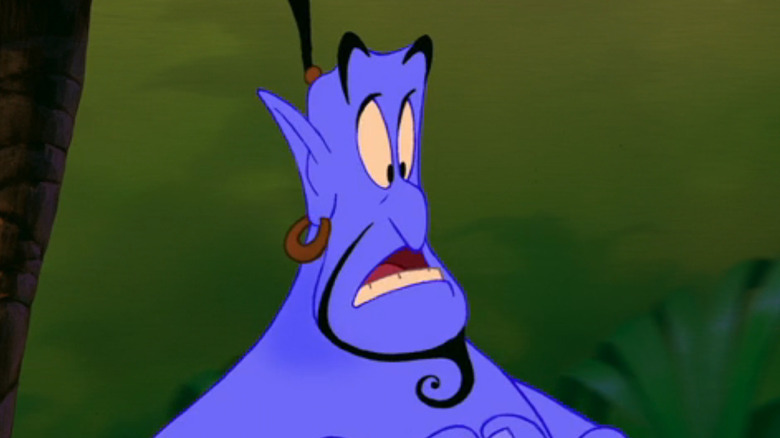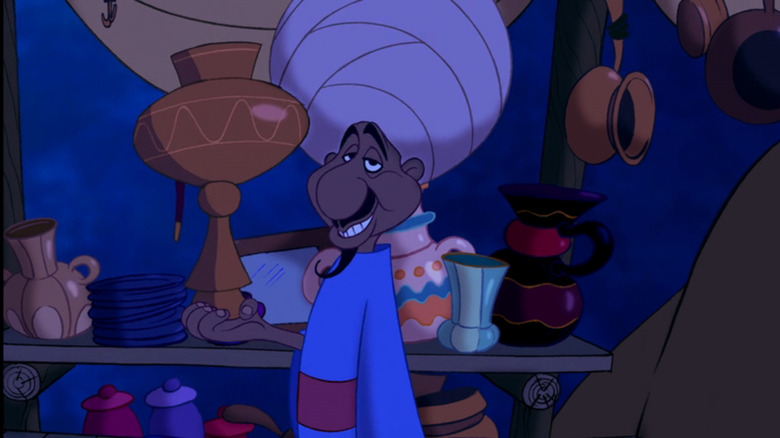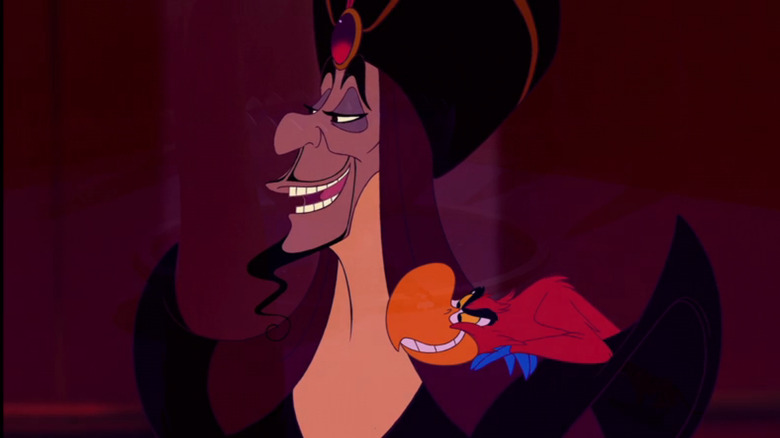The Aladdin Scene That Went Too Far
There's little question that Disney's "Aladdin" remains one of the studio's most beloved animated feature films. When it was first released in 1992, the House of Mouse was in the midst of what's often referred to as the "Disney Renaissance," a period during which the company produced a slate of iconic movies after a relative slump in popularity. Among these were "The Little Mermaid," "Beauty and the Beast," and "The Lion King."
Today, "Aladdin" is best remembered for its late star, Robin Williams, who played the frenetic, pop-culture-referencing Genie. With Scott Weinger as Aladdin, Linda Larkin as Princess Jasmine, and Jonathan Freeman as Jafar, the movie also features yet another departed comedy legend in Gilbert Gottfried as the bird Iago. As if that weren't enough, the score by Alan Menken features some of Disney's most memorable musical numbers, such as "A Whole New World."
But while "Aladdin" remains a delightful tale of romance and magic, it was also a product of its time and, as such, contains some moments that have aged poorly, to say the least. Unfortunately, the "Aladdin" scene that went too far is also the very first scene in the movie.
Arabian Nights is awash in ethnic stereotypes
The opening of "Aladdin" is a musical number entitled "Arabian Nights," and while the song has been denounced for its Middle Eastern stereotypes, the theatrical release was far more problematic than the still-somewhat-problematic version you can now find on home video or Disney+. Sung by Bruce Adler, the song featured the lines, "I come from a land / Where the caravan camels roam / Where they cut off your ear / if they don't like your face / It's barbaric, but hey, it's home." In the movie, the song is sung by a caricature of an Arab man with a comically large nose who aggressively tries to sell hookahs. In the span of a few minutes, "Aladdin" manages to portray Middle Eastern countries as barbaric and presents their peoples as untrustworthy, camel-herding hucksters, all before the opening credits have finished rolling. Unsurprisingly, many took issue with this racist portrayal of another culture by white artists.
As the Los Angeles Times reported in 1993, Disney changed the lyrics of the song at the behest of the American-Arab Anti-Discrimination Committee, removing the reference to cutting off ears and replacing those bars with, "Where it's flat and immense / and the heat is intense." However, the committee was still displeased with the retention of the word "barbaric."
Today, should you fire up "Aladdin" on Disney+, an un-skippable message appears before the film starts, reading in part, "This program includes negative depictions and/or mistreatment of people or cultures. These stereotypes were wrong then and are wrong now."
Orientalism haunts many of Disney's most iconic films
While today, Disney appears to be making small strides toward diversity and the accurate representation of nonwhite or nonwestern cultures, many Disney films contain moments that have aged poorly thanks to their depictions of race, and "Aladdin" fits the bill for what literary scholars call Orientalism. First outlined by Columbia University professor Edward Said in his seminal 1978 book, simply titled "Orientalism," Said defines the concept to mean, "the idea of European identity as a superior one in comparison with all the non-European peoples and cultures ... reiterating European superiority over Oriental backwardness, usually overriding the possibility that a more independent, or more skeptical, thinker might have had different views on the matter." He traces the Orientalizing of non-European peoples to the colonial history of Europe, when white men traveled to far-off lands and returned home to entertain their fellow Europeans with often inaccurate tales of the peoples living there.
In "Aladdin," Orientalism emerges immediately, with the Arabian setting of the film labeled "barbaric." Since something can only be barbaric in contrast to a more civilized way of living, Western viewers are meant to interpret the city of Agrabah — in contrast to their home country — as an exoticized "city of mystery, of enchantment," to quote our camel-riding friend from the movie's opening number once more. As noted by The Courier, this dichotomy is further emphasized by the movie's villain, Jafar, whose angular facial features and darker skin place him in contrast to our heroes, Aladdin and Princess Jasmine, who have contrastingly lighter skin and more traditionally Western Anglo features.
While "Aladdin" remains a celebrated film, it is certainly worth bearing in mind that it is also a product of the white cultural imagination that birthed it.


